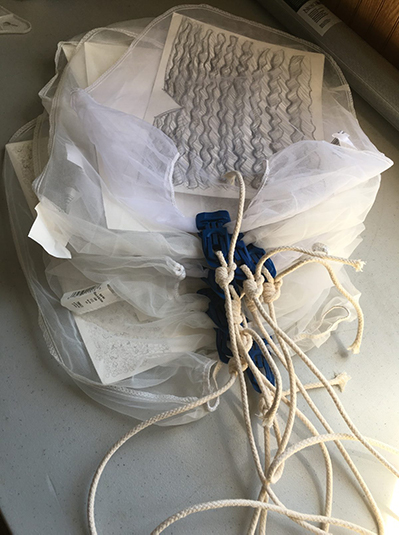

“Water Paintings allowed me to give water at Hubbard Brook’s nine watersheds a voice. In the work, I made water the protagonist. In June 2016, I placed nine pencil drawings and nine pieces of watercolor paper inside nylon mesh. I then tied the mesh bags to a rope at each of the nine weirs at Hubbard Brook Experimental Forest and left them there for a period of 16 weeks in 2016. The water flowing through the mesh stained the paper inside. Water samples and water data were collected by scientists over the same 16-week period from the same nine weirs. The final work included water samples, data, even the residue in filters. I wanted audiences to see the water, what the water did, and what it painted as it flowed and transported materials down the stream.”
– Xavier Cortada


Hubbard Brook Experimental Forest.
Xavier Cortada works with Hydrologist Mark Green to create “Water Paintings” at Hubbard Brook Experimental Forest.
Hubbard Brook scientists pioneered the small watershed approach, which transformed the study of forests by using whole watersheds as living laboratories. This ground-breaking approach fostered many new discoveries beneficial to both science and society.
Small first-order watersheds can show us how ecosystems respond to environmental change. Chemical concentrations combined with stream flow provides data on stream-water element flux for each watershed.
Water samples and data collected by scientists over a 16-week period from all nine watersheds hung on the walls at CLIMA in 2016.
Nine sets of “Water Paintings” hang from the ceiling. Cortada created each using the same water scientists study. He placed watercolor paper in mesh and tied it to a rope in each of the nine weirs. The works depict 4 months of streamflow.


Xavier Cortada, “Water Paintings: Hubbard Brook,” paper and residue captured from water flowing from each of the 9 weirs at the Hubbard Brook Experimental Forest LTER in New Hampshire, 2016.
ABOUT THE HUBBARD BROOK EXPERIMENTAL FOREST AND LTER
Overview: The Hubbard Brook Experimental Forest (HBEF) is a 3,160 hectare reserve located in the White Mountain National Forest operated by the USDA Forest Service, near Woodstock, New Hampshire. The on-site research program is dedicated to the long-term study of forest and associated aquatic ecosystems. It has produced some of the most extensive and longest continuous data bases on the hydrology, biology, geology and chemistry of a forest and its associated aquatic ecosystems. Hubbard Brook scientists discovered acid rain in North America by taking meticulous, long-term measurements of rain and snow. Scientists continue to document acid rain’s damaging effects and track recovery linked to pollution reduction efforts.
Special thanks to the entire Hubbard Brook team, the USDA Forest Service, Dr. Lindsey Rustad, Hydrologist Mark Green, Sr. Researcher Tammy Wooster, Amey Bailey, and Mary Martin.
Learn more at http://www.hubbardbrook.org

Xavier Cortada’s “Water Paintings” exhibition at Pinecrest Gardens.